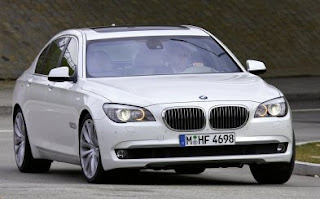
The 760Li at BMW Welt, the new showpiece museum and exhibition centre near the company headquarters in Munich. There was a fitting sense of occasion at the unveiling of a £94,440 flagship car which, according to Wolfgang Stadler, who runs the Dingolfing plant where the 760Li is made, “represents everything that we at BMW stand for”.
If you have bitten the bullet and signed the fat cheque for the car – there is also an M Sport version with a few more extrovert bits costing £96,590 – then BMW will provide you with your own piece of handover theatre. You sit in a private briefing room for a teach-in on the many complex systems hidden within the über-BMW (something all luxury carmakers should do). Your car then appears on a turntable to the accompaniment of flashing lights and “Ride of the Valkyries”, or whatever other music you may choose. Unless, that is, you are ordering a right-hooker for use in the UK. Then you must take delivery in the normal way at the end of the BMW distribution chain.
But feeling like a second-class citizen lasts only until you slip behind the wheel. Because the 760Li really does deserve its flagship status, even if it is only the quadruple exhausts and some extra brightwork that distinguish it at first glance from lesser 7-Series models (which start at £57,000).
For a start, there is its new six-litre twin-turbocharged V12 aluminium engine, a slightly smaller version of the 6.6-litre unit making its debut in the Rolls-Royce Ghost at this month’s Frankfurt motor show.
The BMW unit is remarkable not so much for its horsepower – although 532 horsepower is definitely not to be sneezed at – but its massive, thumping torque and the range over which it is available. All 553lb ft is to hand from a mere 1,500rpm, and all the way to 5,000.
Even though the 760Li weighs a lardy 2.1 tonnes, such prodigious punch requires the 155mph top speed to be put into perspective. The car is still accelerating mightily hard when the electronic limiter cuts in. Its true top speed is much higher – BMW is reluctant to say precisely how much – and the dash from standstill to 62mph is achieved in just 4.2 seconds.
The thrust, however, is much more 747 than Ferrari Scaglietti. The BMW heads for the horizon with barely a murmur from that mighty V12 and virtually imperceptible shifts from its – wait for it – eight-speed automatic gearbox. Developed in partnership with the German transmission producer ZF, it is a conventional automatic with torque converter and thus not quite as fuel-efficient as manual or twin-clutch semi-automatic systems. Even so, the new engine technology results in fuel consumption 5 per cent lower than the model it replaces.
The 760Li is the first car to use the new ZF transmission, although given the car’s huge torque spread, I suspect a simpler six-speed transmission would have sufficed. There are no F1-style gear-change paddles on the steering wheel, for which let us be grateful. They would be inappropriate on a car of such patriarchal demeanour.
There is a short wheelbase version – the 760i, available everywhere except the UK – that could prove more attractive as a driver’s car. But I suspect that many of the long wheelbase cars for the UK will have permanent chauffeurs, with the boss doing more important things in the back.
The rear legroom is simply enormous, the big DVD screens set in the rear of the front seats reminiscent of the TV at home, and there is even a duplicate, rear-console mounted “iDrive” control to operate all the main in-car systems such as satnav, audio, voice recognition and so on – although that has the potential to stress out the poor old chauffeur if he is being permanently second-guessed from the back seat by his employer.
While even this BMW can’t quite match the opulence and sense of well-being that comes with a British wood and leather interior as fitted to an XJ Jaguar, the German interior remains a very rewarding and cosseted place to be. It, too, is awash with wood veneers, leather and Alcantara – the last extending even to the roof lining.
Nevertheless, as you might expect of BMW, a lot of effort has gone into making the 760Li responsive as a driver’s car, should the owner fancy taking the wheel.
There is so-called Dynamic Drive, incorporating adjustable damper and anti-roll settings, with sport and sport-plus modes sharpening suspension, steering, gearbox and accelerator responses. But you really do have to ask yourself whether this is overkill in light of the likely way the car will be used. Even on the softest “comfort” setting, ride and handling are as secure and competent as 99 per cent of buyers are ever likely to wish. As with the just-launched Porsche Panamera, that company’s first stab at a four-door four-seater luxury car, the main effect of the sport setting is a harsher ride in exchange for a modest improvement in handling.
There are toys in abundance, including seats which can cool, heat and massage their occupant, and for the first time on any BMW “Connected Drive”. This is an integrated collection of systems that genuinely elevate the car to a new level of intelligence. There is a lane departure warning, should the driver’s attention stray; active cruise control to stop the car crashing into vehicles in front; an infra-red night vision display that allows you to see humans and other warm-bodied creatures well beyond the range of the headlights; a 12-gigabyte hard drive for everything from internet access to satnav updates; and an emergency assistance notifier that gives the car’s location should its occupants be incapacitated.
Source: ft















